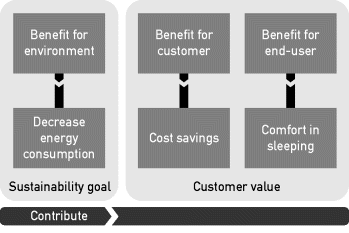1.5 Design for Sustainability (DfS)
The main goal of design for sustainability is sustainable development. The concept of sustainable development was introduced and promoted by the report “Our Common Future” as a common aim for the whole world (Brundtland, 1987). The Brundtland definition of sustainable development describes it as “Development which meets the needs of a current generation without compromising the ability of future generations to meet their needs.”
Even though sustainability is widely accepted as a general goal, nowadays it is interpreted in various ways that can be distinguished by their relative emphasis on economic, social, and ecological aspects.
In order to understand and manage the sustainability concept more transparently, Elkington (1998) developed the framework of the “triple bottom line” comprising the three sustainability components of economic prosperity, environmental quality, and social justice, which further were developed into economy, environment, and social equity. At present, these three key elements of sustainability are frequently referred to as the triple P: people, planet, and profit (see Figure 1.5.1).
Figure 1.5.1 “Triple P,” the three key elements of sustainable development

Initially, sustainability in Europe largely was an environmental (planet) issue. The initial impetus was directed at what is called design for the environment or ecodesign. “Eco-design considers environmental aspects at all stages of the product development process, striving for products which make the lowest possible environment impact throughout the product life cycle” (Brezet and Hemel, 1997). Eco stands here for ecology and economy by looking for improvement options that decrease the environmental impact of the product lifecycle and in the meantime offering opportunities for financial benefits (so-called win–win situations). At present, according to Baumann et al. (2002), the UNEP “Promise” ecodesign manual (Brezet and Hemel, 1997) is most frequently used as a reference material on ecodesign.
The term design for sustainability has a broader and more holistic scope than ecodesign because, apart from environmental aspects, it also incorporates social, ethical, and equity issues into design (Figure 1.5.2). Since 1995, design for sustainability became an accepted approach (Baumann et al., 2002) and a broad description of design for sustainability would be
Figure 1.5.2 Ecodesign versus Design for Sutainability

that industries take environmental and social concerns as a key element in their long-term product innovation strategy. This implies that companies incorporate environmental and social factors into product development throughout the lifecycle of the product, throughout the supply chain, and with respect their socio-economic surrounding, from the local community for a small company, to the global market for a trans-national company (Crul and Diehl, 2006; Diehl and Brezet, 2004).
As an example of design for sustainability, in the following we will discuss a case called the Evening Breeze project (Keskin et al., 2011). Evening Breeze (Keskin et al., 2011) was established in 2006. Among other products, the company developed climate systems integrated in beds (Figure 1.5.3), in agreement with their mission statement in which comfort and sustainability go hand in hand. The climate system locally cools the bed instead of the entire bedroom, and in this scenario 55% energy can be saved compared to cooling a room with air conditioning. The product was promoted as a cost-saving alternative for air conditioning in tropical resorts, since air conditioning accounts for 80% of the total energy use in hotels in the tropics.
Figure 1.5.3 The original Evening Breeze, (Keskin et al., 2011) targeted toward tropical resorts by Thomas van den Groenendaal and Yoeri Nagtegaal

While the initial focus of the Evening Breeze (Keskin et al., 2011) bed was on saving energy, a second market study revealed that hotel guests mainly complained about noise, draft, dry air, and temperature. This stimulated a change in the proposition of the bed involving both comfort and sustainability: “creating the perfect sleeping climate by providing the utmost comfort whilst having minimal environmental impact.” This led to a second version of the bed, the Evening Breeze Canopy (Figure 1.5.4), targeting the Western European consumer market. This stand-alone version of the cooling unit is positioned at the head of the bed and allows customers to keep their existing bed. In terms of market success, the canopy appeared to be more successful than the original Evening Breeze bed, because for tropical resorts, the high cost of initial investment, timing, and maintenance are the most important considerations when purchasing an Evening Breeze bed, whereas for the individual user the experience of a comfortable sleeping environment prevails (Figure 1.5.5). It is interesting to note that the cooling power needed in Western European markets is lower than in the tropics, that is, the Evening Breeze Canopy will be used about 30 days a year versus 300 in a tropical location, leading to energy savings but to a lesser extent than with the original design of the Evening Breeze. Although the reasons that customers in tropical regions give for buying the product vary (e.g., comfort, energy and cost savings, and sustainability), the value of the product is mainly their cost savings due to a reduced electricity bill. In contrast, the value for customers in the Northern Hemisphere mainly comprises luxury and comfort.
Figure 1.5.4 The Evening Breeze Canopy, targeted toward the Western European consumer market

Figure 1.5.5 Translating sustainability into customer values for the Evening Breeze

